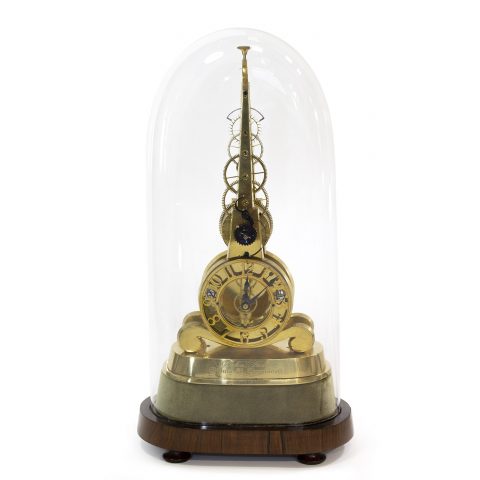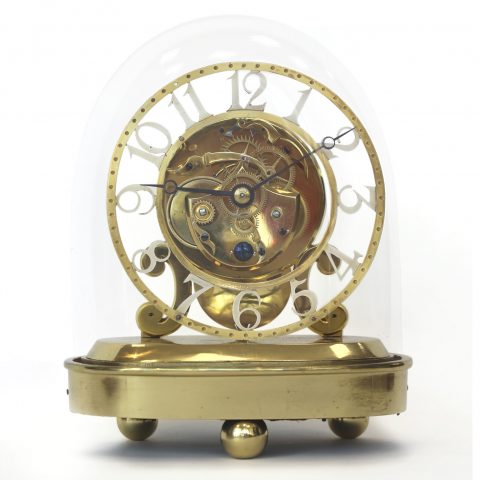Long duration Skeleton Clock by John Pace

A rare and unusual pyramidical antique brass skeleton timepiece of long duration by John Pace, Bury St. Edmunds, No. 253, circa 1855. This very clock is discussed and illustrated in Derek Roberts’ Skeleton Clocks, Britain 1800-1914, page 97.
The substantial cast brass plates that make up the frame have chamfered edges, and are raised on scrolled feet, mounted on a tapered brass plinth signed ‘John Pace BURY St. EDMUNDS No. 253’. This is turn is raised on a velvet plinth and rosewood base, protected under a glass dome.
The eighteen-day duration movement is going barrel. It is clear from literature that these clocks have motionwork driven by cord or watch fusee- sized chain. With respect to this example, there are no witness marks to suggest that a chain has ever been used and we believe that this cord is as original. Indeed I can think of a few good reasons why a cord would be preferential to a chain.
Above the barrel rises a flight of three wheels to the escape wheel, each of five or six crossings, and above this the delicate Graham’s deadbeat escapement and inset jewelled pallets. As stated earlier, these clocks are not all identical – most we know do not have jewelled pallets. This is surmounted by an arched bridge with a knurled screw adjustment to the spring suspension for fine regulation of the timekeeping. The original steel rod pendulum features a most unusual halberd-shaped brass bob. Again most that we have seen have had a later replacement pendulum. Behind the frame is a simple pulley system, linking the centre wheel to drive the minute hand by a fine thread.
The fretted and engine-turned gilt dial has Arabic numerals and blued steel spade hands.
- Height: 43cm
In excellent original condition, the movement to be overhauled and guaranteed for 3 years.
John Pace (d. 1867) is recorded in various local trade directories as working in Bury St. Edmunds between 1804 and 1857. Between 1823 and 1855 his workshop was at (19) Abbeygate Street. He was a deeply religious man who was a member of the Quakers. He had a fine reputation for the skeleton clocks that he made in very close collaboration with Benjamin Parker.
At the 1851 Great Exhibition, Pace exhibited a virtually identical skeleton timepiece of three-month duration. An excerpt from the catalogue reads as follows:
PACE, J., Bury St. Edmunds – Inventor, Designer and Manufacturer.
Pyramidical skeleton timepiece, which goes three month. The dial is placed at the bottom of the clock to show the motion of all the wheels; the Graham’s dead beat escapement, and the hands moved by a simple mechanism.
Also in stock by John Pace:
